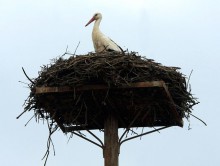“Eurohomes” are special metal support beams on electricity pylons which protect birds from electric shock and consumers from disruptions in electricity supply.
The metal support beams are being installed by employees of Lvivoblenerho Private Joint Stock Company in cooperation with local ornithologists who look for storks’ nests on electricity pylons. Birds love these locations because they offer a good view of the area. However, these nests are dangerous: they get wet and become conductive when it rains, thus threatening storks’ lives. Such homes are even more dangerous to youngest storks who are learning to fly. While straightening their wings for flight, they risk hitting wires and dying.
Lviv ornithologists and Lvivoblenerho’s employees recently visited the village of Monastyrets, Horodok raion, which is considered the stork capital of the region. “Another village, called Poliana, is nearby, just across the Dniester River, and the two villages have over 50 stork nests between them. The birds come back here, because this location offers suitable trees for nest-building and good feeding opportunities, as the village sits in the Dniester valley. The river floods yearly, and there is plenty of food then for white storks, including insects, frogs, reptiles,” ornithologist Andrii Bokotei told us. “In addition, the birds settle on electricity pylons and electricians help them by raising these nests to a height of one meter using special metal support beams... This year, the storks were somewhat late, although March 19 is considered the usual date of their arrival in these parts.”
As many as 10 metal support beams have been installed under stork nests already, and electricians are installing more. According to the ornithologist, Lviv region’s residents joined the “Protection of the White Stork” international initiative back in 2005 and have been keeping up the good work ever since.
This year, the Western Ukrainian Ornithological Society and Lvivoblenerho are going to take care of kestrel, a falcon species which provides considerable assistance to farmers by catching rodents. “Wild population of this bird is low, because their preferred nest locations – old hollow trees – are rare, so we can increase their numbers in two to three years by installing 10 to 15 artificial kestrel nests on electricity pylons which the birds occupy readily,” Bokotei explained.







